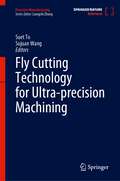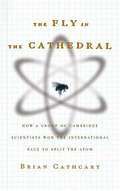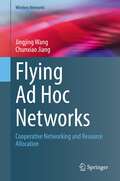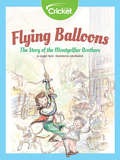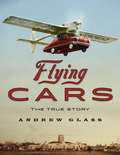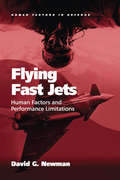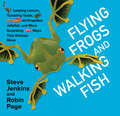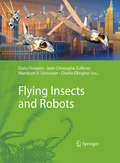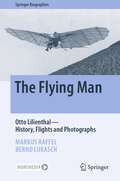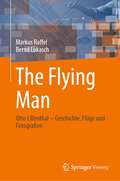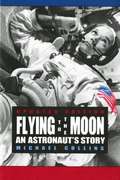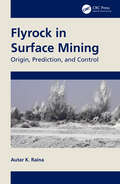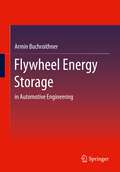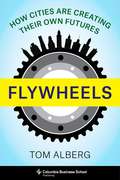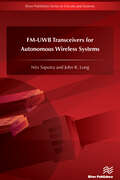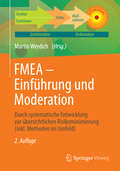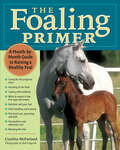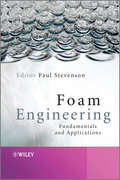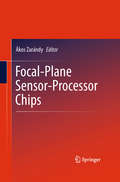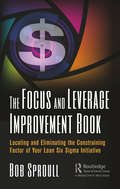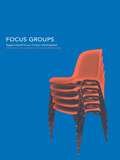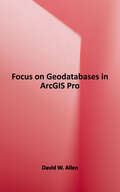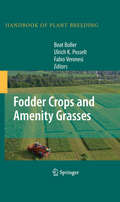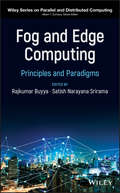- Table View
- List View
Fly Cutting Technology for Ultra-precision Machining (Precision Manufacturing)
by Suet To Sujuan WangThis handbook covers the fly cutting technique, an ultra-precision mechanical machining technology which is regarded as the fastest and most reliable low-cost machining method to generate high quality complex surfaces. The ultra-precision raster milling provides more flexibility and suitability for freeform and structural surfaces with a uniform quality with sub-micrometric form error and nanometric surface roughness. These surfaces are widely applied into optics, medicine, biotechnology, electronics, and communications. The fundamental and latest advancing knowledge of fly-cutting technology is important for the future development and applications in ultra-precision mechanical machining technology. This book provides a good reference for fly-cutting technology in ultra-precision machining for undergraduate and postgraduate students, researchers, engineers, and postdoctoral fellow in advanced manufacturing area. It gives the audience an overview of the working principles, process mechanism, salient features, applications, and research directions of ultra-precision fly-cutting technology.
The Fly in the Cathedral
by Brian CathcartThis book describes how a group of Cambridge scientists won the international race to split the atom.
Flying Ad Hoc Networks: Cooperative Networking and Resource Allocation (Wireless Networks)
by Jingjing Wang Chunxiao JiangRelying on unmanned autonomous flight control programs, unmanned aerial vehicles (UAVs) equipped with radio communication devices have been actively developed around the world. Given their low cost, flexible maneuvering and unmanned operation, UAVs have been widely used in both civilian operations and military missions, including environmental monitoring, emergency communications, express distribution, even military surveillance and attacks, for example. Given that a range of standards and protocols used in terrestrial wireless networks are not applicable to UAV networks, and that some practical constraints such as battery power and no-fly zone hinder the maneuverability capability of a single UAV, we need to explore advanced communication and networking theories and methods for the sake of supporting future ultra-reliable and low-latency applications. Typically, the full potential of UAV network’s functionalities can be tapped with the aid of the cooperation of multiple drones relying on their ad hoc networking, in-network communications and coordinated control. Furthermore, some swarm intelligence models and algorithms conceived for dynamic negotiation, path programming, formation flight and task assignment of multiple cooperative drones are also beneficial in terms of extending UAV’s functionalities and coverage, as well as of increasing their efficiency. We call the networking and cooperation of multiple drones as the terminology ‘flying ad hoc network (FANET)’, and there indeed are numerous new challenges to be overcome before the idespread of so-called heterogeneous FANETs. In this book, we examine a range of technical issues in FANETs, from physical-layer channel modeling to MAC-layer resource allocation, while also introducing readers to UAV aided mobile edge computing techniques.
Flying Balloons: The Story of the Montgolfier Brothers
by Joseph TaylorDid you know hot air balloons were dreamed up by a French boy in the 1700s? Joseph Montgolfier devoted his life to experiments that he hoped would allow him to fly. With the help of his little brother, his invention allowed humans to fly for the first time in history!
Flying Cars: The True Story
by Andrew GlassHumans have always wanted to fly. As soon as there were planes and cars, many people saw a combination as the next step for personal transportation, and visionary engineers and inventors did their best to make the flying car (or the roadable plane) a reality. This book is a breezy account of hybrid vehicles and their creators, and of the intense drive that kept bringing inventors back to the drawing board despite repeated failures and the dictates of common sense. Illustrated with archival photos, this entertaining survey takes readers back as far as Icarus and forward into the present day, with a look toward the future. Includes author's note, source notes, bibliography, index.
Flying Fast Jets: Human Factors and Performance Limitations (Human Factors in Defence)
by David G. NewmanThis book provides a detailed general overview of the human factors and performance limitations associated with flying fast jets, integrating all the latest available research literature on the demanding operational tasks faced by such pilots and aircrews. As such, it has a strong military focus, dealing with pilots of fighter aircraft, attack aircraft and lead-in fighter trainer aircraft that are traditionally only single or dual pilot operations. The book deals not only with the issue of G force, but discusses ejection and escape/survival, disorientation, high altitude physiology, pilot training and selection, helmet-mounted equipment, situational awareness, data fusion and multi-sensor integration, human machine interface issues and advanced cockpit design. It examines the human performance issues associated with the technological advances made in fast jets, such as increased manoeuvrability, increased use of the pilot’s head as a mounting platform for sensor and weapons systems, and the complexities involved in the human-machine interface within these aircraft.
Flying Frogs and Walking Fish: Leaping Lemurs, Tumbling Toads, Jet-Propelled Jellyfish, and More Surprising Ways That Animals Move
by Steve Jenkins Robin PageA red-lipped batfish waddles across the sea floor on its fins, searching for small sea creatures to eat. Other animals may fly or glide, or jet-propel themselves to get around. These creatures come equipped with legs, wings, or tentacles, and they often move from place to place in surprising ways. In the latest eye-catching escape into the kingdom of Animalia, Caldecott Honor-winning team Jenkins and Page show how animals roll, fly, walk, leap, climb, swim and even flip! This fascinating and fun illustrated nonfiction melds science, art, biology, and the environment together in a detailed and well-researched book about how animals move in our world today.
Flying Insects and Robots
by Jean-Christophe Zufferey Mandyam V. Srinivasan Dario Floreano Charlie EllingtonFlying insects are intelligent micromachines capable of exquisite maneuvers in unpredictable environments. Understanding these systems advances our knowledge of flight control, sensor suites, and unsteady aerodynamics, which is of crucial interest to engineers developing intelligent flying robots or micro air vehicles (MAVs). The insights we gain when synthesizing bioinspired systems can in turn benefit the fields of neurophysiology, ethology and zoology by providing real-life tests of the proposed models. This book was written by biologists and engineers leading the research in this crossdisciplinary field. It examines all aspects of the mechanics, technology and intelligence of insects and insectoids. After introductory-level overviews of flight control in insects, dedicated chapters focus on the development of autonomous flying systems using biological principles to sense their surroundings and autonomously navigate. A significant part of the book is dedicated to the mechanics and control of flapping wings both in insects and artificial systems. Finally hybrid locomotion, energy harvesting and manufacturing of small flying robots are covered. A particular feature of the book is the depth on realization topics such as control engineering, electronics, mechanics, optics, robotics and manufacturing. This book will be of interest to academic and industrial researchers engaged with theory and engineering in the domains of aerial robotics, artificial intelligence, and entomology.
The Flying Man: Otto Lilienthal, the World's First Pilot
by Mike DownsHere is the little-known history of Otto Lilienthal, a daring man whose more than 2,000 successful flights inspired the Wright Brothers and other aviation pioneers.In 1862, balloons were the only way to reach the sky. But 14-year-old Otto Lilienthal didn&’t want to fly in balloons. He wanted to soar like a bird. Scientists, teachers, and news reporters everywhere said flying was impossible. Otto and his brother Gustav desperately wanted to prove them wrong, so they made their own wings and tried to take flight. The brothers quickly crashed, but this was just the beginning for Otto, who would spend the next 30 years of his life sketching, re-sketching, and building gliders. Over time, Otto&’s flights got longer. His control got better. He learned the tricks and twists of the wind. His flights even began to draw crowds. By the time of his death at age 48, Otto had made more than 2,000 successful glider flights. He was the first person in history to spend this much time in the air, earning the title of the world&’s first pilot and paving the way for future aviation pioneers.
The Flying Man: Otto Lilienthal—History, Flights and Photographs (Springer Biographies)
by Markus Raffel Bernd Lukasch"Of all the men who attacked the flying problem in the 19th century, Otto Lilienthal was easily the most important. His greatness appeared in every phase of the problem. No one equaled him in power to draw new recruits to the cause; no one equaled him in fullness and dearness of understanding of the principles of flight; no one did so much to convince the world of the advantages of curved wing surfaces; and no one did so much to transfer the problem of human flight to the open air where it belonged." These words were spoken by Wilbur Wright, who successfully accomplished the first powered flight together with his brother Orville in 1903 on the sand dunes of the Outer Banks off the coast of North Carolina. Wilbur was talking about the most important of their predecessors, Otto Lilienthal. Lilienthal attracted worldwide attention due to the spectacular photographs showing him in flight, made possible by technology that had only just been developed by him. This fortuitous union between a pioneer of aviation and the pioneers of so-called “instantaneous photography” is responsible for the immense contemporary popularity of Lilienthal’s flights around the globe, the first ever free flights performed by man. This book traces the life of the German aviation pioneer, focusing on the designs of his many aircraft and the photographic documentation that has survived. The presentation ends with a remarkable research project conducted by one of the authors, right up to and including his own training exercises with Lilienthal’s “normal soaring apparatus” and “large biplane”. This project offered new insight into Lilienthal’s work, and also led to a spectacular aerial meeting of Lilienthal's 1895 biplane and the Wright brothers’ 1902 biplane at a historic location on the Outer Banks. The book provides access to video material, largely stemming from this project.
The Flying Man: Otto Lilienthal – Geschichte, Flüge und Fotografien
by Markus Raffel Bernd Lukasch"Von allen Männern, die sich im 19. Jahrhundert mit dem Problem der Fliegerei beschäftigten, war Otto Lilienthal mit Abstand der bedeutendste. Seine Größe zeigte sich in jeder Phase des Problems. Niemand kam ihm gleich in der Fähigkeit, neue Mitstreiter für die Sache zu gewinnen; niemand kam ihm gleich in der Fülle und Tiefe des Verständnisses der Prinzipien des Fliegens; niemand tat so viel, um die Welt von den Vorteilen gekrümmter Flügeloberflächen zu überzeugen; und niemand tat so viel, um das Problem des menschlichen Fluges in die freie Luft zu verlegen, wo es hingehörte."Diese Worte stammen von Wilbur Wright, der 1903 zusammen mit seinem Bruder Orville auf den Sanddünen der Outer Banks vor der Küste North Carolinas den ersten Motorflug erfolgreich absolvierte. Wilbur sprach dabei über den bedeutendsten ihrer Vorgänger, Otto Lilienthal.Lilienthal erregte weltweites Aufsehen durch die spektakulären Fotos, die ihn im Flug zeigten und die durch eine Technologie ermöglicht wurden, die er gerade erst entwickelt hatte. Diese zufällige Verbindung zwischen einem Pionier der Luftfahrt und den Pionieren der so genannten "Moment- oder Augenblicksfotografie" ist verantwortlich für die immense zeitgenössische Popularität von Lilienthals Flügen rund um den Globus, den ersten Freiflügen eines Menschen überhaupt. Dieses Buch zeichnet das Leben des deutschen Luftfahrtpioniers nach und konzentriert sich dabei auf die Konstruktionen seiner zahlreichen Flugzeuge und die erhaltene fotografische Dokumentation. Die Darstellung endet mit einem bemerkenswerten Forschungsprojekt, das einer der Autoren bis hin zu eigenen Übungsflügen mit Lilienthals "Normalsegelflugapparat" und "großem Doppeldecker" durchgeführt hat. Dieses Projekt bot neue Einblicke in Lilienthals Arbeit und führte auch zu einer spektakulären Luftbegegnung von Lilienthals Doppeldecker von 1895 und dem Doppeldecker der Gebrüder Wright von 1902 an einem historischen Ort auf den Outer Banks. Das Buch bietet Zugang zu Videomaterial, das größtenteils im Rahmen dieses Projekts entstanden ist.
Flying to the Moon: An Astronaut's Story
by Michael CollinsIn this entrancing account, space traveler Michael Collins recalls his early days as an Air Force test pilot, his astronaut training at NASA, and his unparalleled experiences in orbit, including the Apollo 11 mission, the first manned lunar landing. The final chapter to his autobiography, revised and updated for this edition, is an exciting and convincing argument in favor of mankind's continued exploration of our universe.
Flyrock in Surface Mining: Origin, Prediction, and Control
by Autar K. RainaThis book provides a comprehensive understanding of historical and recent research, with a critical review of several aspects of the flyrock phenomenon, along with classification of pertinent literature. This puts flyrock into proper perspective and develops a comprehensive regime for flyrock prediction and control. It also addresses the blast danger zone demarcation based on scientific understanding in comparison to the consequence-based approach supported by pertinent case studies. Features: Discusses exclusive material on flyrock in surface mining. Presents comprehensive and critical review of the flyrock phenomenon. Reviews prediction and control mechanisms in vogue with scientific and risk-based definitions of blast danger zone. Provides new insights into the flyrock definitions, prediction, and prevention along with the research approach to the problem. Includes Indian case studies and summarize global data available in the published domain. This book is aimed at researchers and graduate students in mining and civil engineering, engineering geology, and blasting.
Flywheel Energy Storage: in Automotive Engineering
by Armin BuchroithnerStoring energy is one of the most important challenges of our time. Energy storage systems are not only essential for switching to renewable energy sources, but also for all mobile applications. Electro-mechanical flywheel energy storage systems (FESS) can be used in hybrid vehicles as an alternative to chemical batteries or capacitors and have enormous development potential. In the first part of the book, the Supersystem Analysis, FESS is placed in a global context using a holistic approach. External influences such as the vehicle, driver and operating strategy, including socio-psychological aspects, are analyzed with regard to their interaction with the memory. From this, optimal application scenarios are derived and the development goals relevant for market success are defined. In the second part, the consideration of the subsystem, those critical components in the FESS are identified which are responsible for the achievement of the technical target properties. From the point of view of maximum cost reduction, specific solutions for the design of the key components are presented and their suitability is validated through empirical studies on the housing, bearing and rotor as well as through overall prototypes.This book is a translation of the original German 1st edition Schwungradspeicher in der Fahrzeugtechnik by Armin Buchroithner published by Springer Fachmedien Wiesbaden GmbH, part of Springer Nature in 2019.
Flywheels: How Cities Are Creating Their Own Futures
by Tom AlbergOnce a blue-collar outpost, Seattle, home to Microsoft, Amazon, and hundreds of startups, transformed into one of the world’s major innovation hubs in less than twenty years. As other cities try to solve the riddle of creating vibrant economies, many have looked to Seattle as a model for tech-driven urban renaissance. However, that success comes with skyrocketing housing costs, increasing homelessness, public safety concerns, persistent racial inequality, and a widening gap between the haves and have-nots. Against that backdrop, big tech has become a popular target.Tom Alberg, a venture capitalist who was one of the first investors in Amazon, draws on his experience in Seattle’s tech boom to offer a vision for how cities and businesses can build a brighter future together. He explores ways that cities can soar to prosperity by creating the conditions that encourage innovation. Like flywheels, livable cities generate momentum by drawing creative citizens who launch businesses. Success attracts more talent, energizing local economies and accelerating further innovation. Alberg emphasizes the importance of city governments and tech companies partnering to address civic challenges. He reflects on why the benefits of the tech boom have not been distributed equally and what business and government leaders must do differently to ensure inclusive growth. The book also examines success stories from smaller cities and their lessons for other up-and-coming tech hubs. Demonstrating the need for innovative thinking that encourages livability alongside economic growth, Flywheels is timely reading for everyone from mayors to business leaders to engaged citizens.
FM-UWB Transceivers for Autonomous Wireless Systems
by Nitz Saputra John R. LongSignificant research effort has been devoted to the study and realization of autonomous wireless systems for wireless sensor and personal-area networking, the internet of things, and machine-to-machine communications. Low-power RF integrated circuits, an energy harvester and a power management circuit are fundamental elements of these systems. An FM-UWB Transceiver for Autonomous Wireless Systems presents state-of-the-art developments in low-power FM-UWB transceiver realizations. The design, performance and implementation of prototype transceivers in CMOS technology are presented. A working hardware realization of an autonomous node that includes a prototype power management circuit is also proposed and detailed in this book.Technical topics include: Low-complexity FM-UWB modulation schemesLow-power FM-UWB transceiver prototypes in CMOS technologyCMOS on-chip digital calibration techniquesSolar power harvester and power management in CMOS for low-power RF circuitsAn FM-UWB Transceiver for Autonomous Wireless Systems is an ideal text and reference for engineers working in wireless communication industries, as well as academic staff and graduate students engaged in electrical engineering and communication systems research.
FMEA - Einführung und Moderation
by Martin WerdichDieses Buch hilft Ihnen, die Methodik FMEA sowie die angrenzenden Themen zu verstehen und anzuwenden. Es räumt mit dem Vorurteil auf, FMEA wäre "nur" ein Qualitätstool, das von Qualitätsspezialisten durchgeführt wird. Vielmehr kann die FMEA in jeder Branche als Werkzeug benutzt werden, um Produkte, Projekte, Aufgaben und Dienstleistungen äußerst planbar, nachvollziehbar und zielorientiert umzusetzen. Das strukturierte Vorgehen unterstützt Problemlösungen und schafft somit neue Denkansätze (präventive Qualitätssicherungsmethodik und Risikoanalyse). Bei richtiger Anwendung werden Sie Zeit, Geld und Kapazität einsparen.
The Foaling Primer: A Step-by-Step Guide to Raising a Healthy Foal
by Cynthia McFarlandStart your foal off on the right hoof! With correct handling, health care, and training during the first year, you can establish a strong foundation that will benefit your horse throughout his life. From bottle feeding to rope leading, Cynthia McFarland covers everything you need to know as you guide your foal from birth to yearling. With an emphasis on recognizing critical developmental signs, McFarland’s expert advice will help you raise a healthy, happy, and well-adjusted foal.
Foam Engineering
by Paul StevensonContaining contributions from leading academic and industrial researchers, this book provides a much needed update of foam science research. The first section of the book presents an accessible summary of the theory and fundamentals of foams. This includes chapters on morphology, drainage, Ostwald ripening, coalescence, rheology, and pneumatic foams.The second section demonstrates how this theory is used in a wide range of industrial applications, including foam fractionation, froth flotation and foam mitigation. It includes chapters on suprafroths, flotation of oil sands, foams in enhancing petroleum recovery, Gas-liquid Mass Transfer in foam, foams in glass manufacturing, fire-fighting foam technology and consumer product foams.Key features:Foam fractionation is an exciting and emerging technology, starting to gain significant attentionDiscusses a vital topic for many industries, especially mineral processing, petroleum engineering, bioengineering, consumer products and food sectorLinks foam science theory to industrial applications, making it accessible to an engineering science audienceSummarizes the latest developments in this rapidly progressing area of researchContains contributions from leading international researchers from academia and industry
Focal-Plane Sensor-Processor Chips
by Ákos ZarándyFocal-plane sensor-processor imager devices are sensor arrays and processor arrays embedded in each other on the same silicon chip. This close coupling enables ultra-fast processing even on tiny, low power devices, because the slow and energetically expensive transfer of the large amount of sensory data is eliminated. This technology also makes it possible to produce locally adaptive sensor arrays, which can (similarly to the human retina) adapt to the large dynamics of the illumination in a single scene This book focuses on the implementation and application of state-of-the-art vision chips. It provides an overview of focal plane chip technology, smart imagers and cellular wave computers, along with numerous examples of current vision chips, 3D sensor-processor arrays and their applications. Coverage includes not only the technology behind the devices, but also their near- and mid-term research trends.
The Focus and Leverage Improvement Book: Locating and Eliminating the Constraining Factor of Your Lean Six Sigma Initiative
by Bob SproullCompanies all over the world try their best to improve their business by implementing efforts such as Six Sigma, Lean Manufacturing, or a combination of the two methodologies. Logic would tell you that these two methods would be the right approach because you would have an improvement method that, through Lean, reduces waste and make value flow, while Six Sigma reduces and controls variation. If this were true, then why is it that many of these initiatives simply aren’t delivering quantifiable bottom-line results? After having studied many of these on-going improvement efforts, the author believes that these efforts are missing an important focusing mechanism. That is, most of these improvement efforts attempt to improve "everything" rather than finding that key part of the system that should be assessed and improved, the constraining factor, and then focusing the improvement efforts there and only there. The hallmark of this book is how to first locate this constraining factor and then determine the best way to exploit it to generate extreme profits, radically improve on-time delivery of products or services and increase market share by outperforming your competition at rates you never expected possible. How do we do this? By combining Lean and Six Sigma with the Theory of Constraints. This book demonstrates both the basics of improvement (i.e. results) with the "how to" (i.e. the methodology) in a very simple format that everyone within your organization will understand.
Focus Groups: Supporting Effective Product Development
by Joe Langford Deana McDonaghThe focus group is widely used to as a tool for increasing the understanding of users and their requirements, and identifying potential solutions for these requirements. Its main value lies in the conveyance of less tangible information that cannot be obtained using more traditional methods. Eliciting user needs beyond the functional is crucial for
Focus on Geodatabases in ArcGIS Pro (Focus On)
by David W. AllenThis book introduces readers to the geodatabase, the comprehensive information model for representing and managing geographic information across the ArcGIS platform. Sharing best practices for creating and maintaining data integrity, chapter topics include the careful design of a geodatabase schema, building geodatabases that include data integrity rules, populating geodatabases with existing data, working with topologies, editing data using various techniques, building 3D views, and sharing data on the web. Each chapter includes important concepts with hands-on, step-by-step tutorials, sample projects, and datasets, 'Your turn' segments with less instruction, study questions for classroom use, and an independent project. Instructor resources are available by request.
Fodder Crops and Amenity Grasses
by Fabio Veronesi Ulrich K. Posselt Beat BollerThe main role of grasses, clovers and alfalfa in temperate agriculture is still to provide forage for ruminant animals but, in the last decades, the importance of amenity grasses increased markedly and, in the near future, new developments in the areas of energy and biomass use can be envisaged. Fodder Crops and Amenity Grasses, fifth volume in the series, Handbook of Plant Breeding, covers all these aspects. Most fodder crops and amenity grasses are perennials and many of them are natural or induced polyploids. Thus, breeding procedures and strategies differ greatly from breeding annual field crops. Breeding objectives are more difficult to define in forage crops because direct measurement of the efficiency of animal production during breeding and variety assessment is impractical. As a result, a large number of selection criteria have been developed for the particular crops. However, breeding objectives and methodology have a common basis among these species and are therefore presented in the general chapters. Particular emphasis is placed on the breeding methodology for cross-pollinating species because the large majority of crops belong to this group. In addition, the potential of new molecular techniques to complement breeding concepts and strategies is presented and critically discussed. Special techniques and procedures as well as particular breeding goals will be included in the crop specific chapters. Amenity grass breeding has its own breeding objectives and testing procedures, however, the species are mostly the same as in forage grass breeding, and crop specific chapters will include the amenity aspects where appropriate. The crop specific chapters will cover the range of topics given in the guidelines below. The volume on Fodder Crops and Amenity Grasses is the fifth volume in series Handbook of Plant Breeding after the initial volumes on Vegetables, Cereals, Oil Crops and Fruits. Like the other volumes in the series, the volume presents information on the latest scientific information in applied plant breeding using the current advances in the field, from efficient use of genetic resources to impact of biotechnology in plant breeding. Outstanding scientists from all over the world have contributed chapters to the work.
Fog and Edge Computing: Principles and Paradigms (Wiley Series on Parallel and Distributed Computing)
by Rajkumar Buyya Satish Narayana SriramaA comprehensive guide to Fog and Edge applications, architectures, and technologies Recent years have seen the explosive growth of the Internet of Things (IoT): the internet-connected network of devices that includes everything from personal electronics and home appliances to automobiles and industrial machinery. Responding to the ever-increasing bandwidth demands of the IoT, Fog and Edge computing concepts have developed to collect, analyze, and process data more efficiently than traditional cloud architecture. Fog and Edge Computing: Principles and Paradigms provides a comprehensive overview of the state-of-the-art applications and architectures driving this dynamic field of computing while highlighting potential research directions and emerging technologies. Exploring topics such as developing scalable architectures, moving from closed systems to open systems, and ethical issues rising from data sensing, this timely book addresses both the challenges and opportunities that Fog and Edge computing presents. Contributions from leading IoT experts discuss federating Edge resources, middleware design issues, data management and predictive analysis, smart transportation and surveillance applications, and more. A coordinated and integrated presentation of topics helps readers gain thorough knowledge of the foundations, applications, and issues that are central to Fog and Edge computing. This valuable resource: Provides insights on transitioning from current Cloud-centric and 4G/5G wireless environments to Fog Computing Examines methods to optimize virtualized, pooled, and shared resources Identifies potential technical challenges and offers suggestions for possible solutions Discusses major components of Fog and Edge computing architectures such as middleware, interaction protocols, and autonomic management Includes access to a website portal for advanced online resources Fog and Edge Computing: Principles and Paradigms is an essential source of up-to-date information for systems architects, developers, researchers, and advanced undergraduate and graduate students in fields of computer science and engineering.
